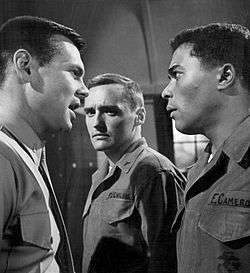To Set It Right
"To Set It Right" is the 21st episode of the American military drama television series The Lieutenant, produced for broadcast on NBC. Written by Lee Erwin, and featuring a guest cast that included Dennis Hopper, Don Marshall, Woody Strode and the acting debut of Nichelle Nichols. The series followed the lives of the United States Marine Corps stationed at Marine Corps Base Camp Pendleton. In this episode, after a racially driven altercation between Cpl. Peter Devlin (Dennis Hopper) and Pvt. Ernest Cameron (Don Marshall), Lt. William Rice (Gary Lockwood) attempts to settle their issues by first arranging a boxing match, and then forcing them to work together on a march. Following protests by the Pentagon, who had previously aided the production of the series, the network refused to air the episode.
| "To Set It Right" | |
|---|---|
| The Lieutenant episode | |
 Publicity photo for "To Set It Right", featuring Gary Lockwood, Dennis Hopper and Don Marshall | |
| Episode no. | Season 1 Episode 21 |
| Directed by | Vincent McEveety |
| Written by | Lee Erwin |
| Produced by | Norman Felton Del Reisman Gene Roddenberry |
| Original air date | February 22, 1964 (intended) |
| Guest appearance(s) | |
| |
Production
The Lieutenant was developed in conjunction with the Pentagon; but following a series of plot points featuring in the series that concerned officials there, relations were strained.[1] They were concerned with the plot of "To Set It Right", and warned the producers that the airing of the episode that this could result in the production no longer being able to use the equipment and extras provided by the marines for free. In response, Roddenberry informed the National Association for the Advancement of Colored People, who attempted to pressure the network to air the episode.[2] The assistance of the Pentagon was withdrawn,[1] and the series was officially cancelled a week later.[2]
Reception
Donald Bogle wrote of the episode in his 2001 book Primetime Blues: African Americans on Network Television, saying that the episode "lost its nerve and ultimately undermined the feelings - the very strong, modern Black perspective - of its character Cameron". This resulted in the character appearing to be "one more angry young negro with unjustified racial hostility". However, Bogle praised the interactions between Rice and Norma and said that this was a better articulation of the problems faced by Cameron than those explained by the actual character.[3] Bogle felt that although "To Set It Right" sought to address racial issues, it wanted to avoid upsetting its main viewers.[4]
A videotape of the episode is in the collection of the Paley Center for Media in New York, contributed to the center by Gene Roddenberry.[5]
Notes
- Robb 2012, p. 85.
- Gross & Altman 2016, p. 62.
- Bogle 2001, p. 105.
- Bogle 2001, p. 106.
- "Lieutenant, The: To Set It Right (TV)". The Paley Center for Media. Retrieved September 1, 2013.
References
- Bogle, Donald (2001). Primetime Blues: African Americans on Network Television. New York: Farrar, Straus and Giroux. ISBN 978-0-37423-720-2.CS1 maint: ref=harv (link)
- Gross, Edward; Altman, Marc (2016). The Fifty-Year Mission: Volume One: The First 25 Years. New York: Thomas Dunne Books/St. Martin's Press. ISBN 978-1-25006-584-1.CS1 maint: ref=harv (link)
- Nichols, Nichelle (1994). Beyond Uhura. New York: G. P. Putnam's. ISBN 0-3991-3993-1.CS1 maint: ref=harv (link)
- Robb, Brian J. (2012). A Brief Guide to Star Trek. London: Robinson. ISBN 978-1-849-01514-1.CS1 maint: ref=harv (link)